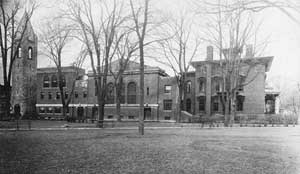
Tompkins County is divided by Cayuga Lake, the second longest of the glacially created Finger Lakes. The lake, 435 feet deep at its core, with its headwaters at the southern end, is fed by streams that make their way through gorges cut in the underlying shale and limestone that make up the county’s geologic base. The county today consists of 476.1 square miles; the southern end rugged terrain with Connecticut Hill reaching 2,095.97 feet. The northern portion presents a more gentle and fertile terrain.

courtesy of The History Center
Railroad development linked Tompkins County with the markets and destinations beginning in 1832 with the horse-drawn Ithaca-Owego Railroad. By the 1870s, there were four major railway lines running through Ithaca. Lake travel began in 1823 and continued into the twentieth century.
Ithaca College opened in downtown Ithaca buildings in 1892, at first a music academy, then expanding into a number of fields. The college moved to South Hill in 1969. Significant industries in the county include the Ithaca Gun Company, the Thomas-Morse airplane company, and the Groton Iron Bridge Company–all of which are now gone. For a decade, beginning in 1914, movies were made in Ithaca.

Population growth in the twentieth century continued only slowly, although the university from 1885 increased yearly in size bringing faculty, hiring local staff, and drawing students in ever-growing numbers. In 1910 there were 33,647 residents in the county. The increase thereafter was slight until 1940 when the total population of Tompkins County was 42,340. In the next ten years the overall population jumped by more than 16,000 residents to 59,122, with the major gain occurring in Ithaca, reflecting the dramatic growth of Cornell University following the second World War. An additional jump by 10,000 residents between 1960 and 1970 brought the county population to 77,064. That decade’s figures reveal a shift in living patterns with a major increase in the Town of Ithaca, especially in the northeast portion and in the areas adjacent to Cornell.
By the 2000 federal census, the population of Tompkins County was 96,501. The ethnic composition of the county had also changed. There had been a major influx of Irish immigrants in the 1830s and ‘40s. Late in the nineteenth-century, Italians and some identified as Hungarians began to arrive. Early in the twentieth century newcomers included Italians, Hungarians, Greeks, and Finns. In 1900 there were two Chinese listed in the Federal Census. By 2000 the County housed a diversified Asian community along with Hispanics, Russians, and a small but significant contingent of Tibetans who founded a monastery, first on North Aurora Street and in 2008 along the Danby Road (route 96 south). The student population at Cornell is nearly twenty thousand.
The major business of the county is education, with Cornell, Ithaca College, the Tompkins Cortland Community College, and six public school systems plus several private schools and the Community School of Music and Art (CSMA). Agriculture continues to be important; there is an active Farmer’s Market featuring food grown in the area. Tompkins County also attracts tourists to its Discovery Trail of important museums: the Museum of the Earth, the Sciencenter, the Johnson Art Museum, the History Center. More than sixty cultural organizations, including historical societies, drama companies, musical groups of all kinds, dance companies and an orchestra and opera society flourish. There is a stunning cycle of events each year that include the Ithaca Festival, which occurs the first weekend of June, the Grassroots Festival each summer, Light in Winter each January, and an Art Trail open all year long with featured weekend events in the spring and fall.

There is a major business complex adjacent to the County Airport. Over 80 companies in the county are here because their founders studied or taught at the university.
Traditionally the county, outside the City of Ithaca, voted Republican. With the increase of population after 1950, the Democratic core increased and in 1993 the County Board for the first time had a Democratic majority.
The county is served daily by The Ithaca Journal, which began in 1814, The [Cornell] Daily Sun [1880], and The Ithaca Times, a weekly news publication.
The county’s history was first treated in H. Hurd, History of Chemung, Schuyler, Tioga and Tompkins Counties, New York (Philadelphia, 1879) and in John Selkreg, Landmarks of Tompkins County (Syracuse, 1894). Horace King wrote an essay about Ithaca in 1847, H. C. Goodwin published Ithaca as it Was, and Ithaca as it Is, in 1853, and Henry Abt published Ithaca, in 1926. Recent treatments include Carol Kammen, Peopling of Tompkins County: A Social History (Interlaken, 1985) and Jane M. Dieckmann, A Short History of Tompkins County (Ithaca, 1986). Also useful is W. Glenn Norris, The Origin of Place Names in Tompkins County (Ithaca, 1951) or the updated Place Names of Tompkins County, published in 2003 by the Municipal Historians of Tompkins County. There is also The Towns of Tompkins County, edited Jane M. Dieckmann (Ithaca, 1998). See also The Architectural Heritage of Tompkins County with photographs by Richard Corth, published in 2002.
